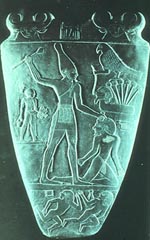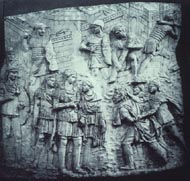|
|

|
|
| Augustus of Primaporta, 20 B.C. or c. 14 A.D. | Imperial Procession from the Ara Pacis, 13-9 B.C. | |

|
||
Trajan, cuirass statue, Louvre. |
Marcus Aurelius, cuirass statue, Louvre. 161-180 AD | |
| Togatus statue of Augustus, Louvre, head dated between 30-20BC; the body probably comes from the 2nd century AD. It represents Augustus as a magistrate. | Augustus as Pontifex Maximus, 1st c. A.D. | |
|
|
||
Equestrian Statue of Marcus Aurelius, c. 165 A.D., bronze. |
||


|

|
|
| Arch of Titus, 81 A.D., Rome, constructed by Domitian after the death of Titus. | Triumphal Procession with the spoils from the
Temple of Jerusalem, relief from the Arch of Titus. |
|

|
Josephus description of the Triumph | |
| Triumph of Titus, relief from the Arch of Titus. | ||

|

|
|
| Reconstruction of th Forum of Trajan (note presence of Triumphal Arch, equestrian statue, and column. | Reconstruction of the Forum of Trajan. | |
|
|
||
| Column of Trajan, c. 106-113 A.D. | View of the base of the Column of Trajan. | |

|

|
|
| Roman army crossing the Danube river at the outset of the first Dacian campaign. | River God (Danube), cartoon with Jupiter throwing thunderbolt, and Nike inscribing shield from the Column of Trajan. | |

|
||
| Trajan greeting ambassadors | Trajan meeting with local Chieftain. | |

|

|
|
| Battle scene from the Column. Suicide of Decabalus. | Submission scene. | |
Additional Web Pages
Panel Reliefs of Marcus Aurelius and Roman Imperial Iconography
Column of Trajan with details of reliefs
Column of Trajan (includes cartoons so that you can follow the whole narrative)







